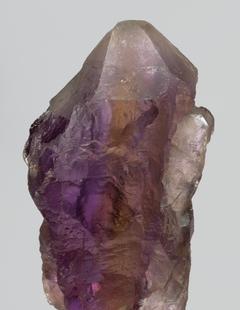
10mm
767x992 93kb - 1534x1984 309kb
Ametrine is a quartz that has alternating violet and yellow segments in the crystal. The name is just a combination of amethyst and citrine. When such a crystal is cut perpendicular to its c-axis, the slabs have a pinwheel-like appearance. An ideal ametrine will have 3 violet and 3 yellow sectors (hence the other name trystine), but in nature this is not always so.
Ametrine appeared on the market in the early 1980s, and first many had doubts about it being a natural quartz variety and not some fancy artificial product. Its origin was kept a secret, and it was already known that amethyst could be treated in ways that would yield similar crystals.
Ametrine is in a sense much more an amethyst than it is citrine. As in amethyst, the color of the violet sectors is caused by the presence of iron with an oxidation number of 4, Fe(+4), built into its crystal framework as a replacement for Si and subsequent irradiation from radioactive elements. The yellow color is caused either by inclusions of iron compounds or by iron ions, Fe3+, built into the crystal lattice. The concentration of iron is much higher in the yellow than in the violet sectors. If one heats up a natural ametrine, only the violet sectors loose their color, and the result is a specimen with 3 almost colorless and 3 yellow sectors. The violet color appears mostly under the r-faces, while the sectors under the z-faces are usually yellow. For this to work, the crystal either has to be untwinned or twinned according to the Brazil law (left and right quartz contact twin). A Dauphiné twin can't be an ametrine as it lacks distinguishable r- and z-rhombohedra and is a penetration twin, so the colored areas would have an irregular shape. Ametrines are in fact Brazil twins, just like most amethysts. The polysynthetical twinning is often confined to the violet areas under the r-rhombohedra, whereas the yellow areas under the z rhombohedra are sometimes untwinned.
Note: There are some locations (e.g. Peterson Mountain, Nevada) where one can find crystals that have yellow, violet and smoky zones. I will not call those ametrine, because the color zones, at least for the amethyst-colored and citrine-colored parts of the crystals, seem to reflect different stages in the development of the crystal, and do not form a specific pattern. Judging from what I have seen so far, the "amethyst part" of multicolored specimen frequently seems to be formed as scepter on top of the "citrine-part". The smoky quartz and amethyst parts, and the smoky quartz and citrine parts in these specimens can very well overlap or show gradual transitions. Ametrine, on the other hand, has a very specific, law-like pattern of coloration that reflects the internal crystal structure.

10mm 767x992 93kb - 1534x1984 309kb |
|
Source: http://www.quartzpage.de/print/ametrine.html |
Home: www.quartzpage.de |